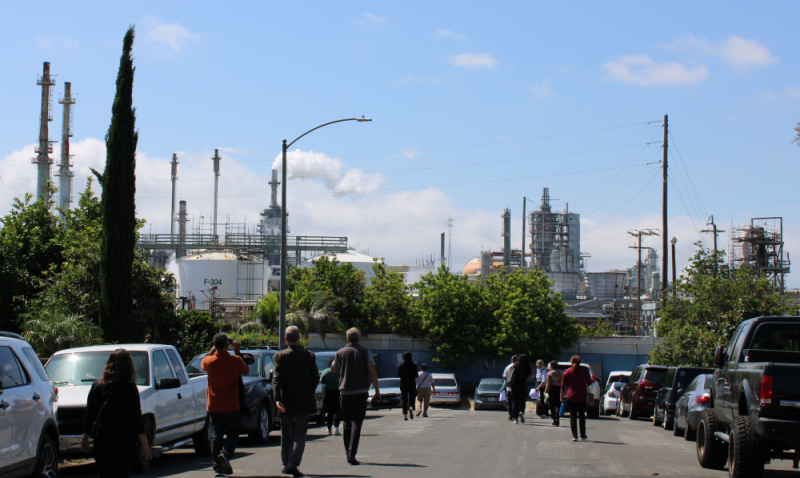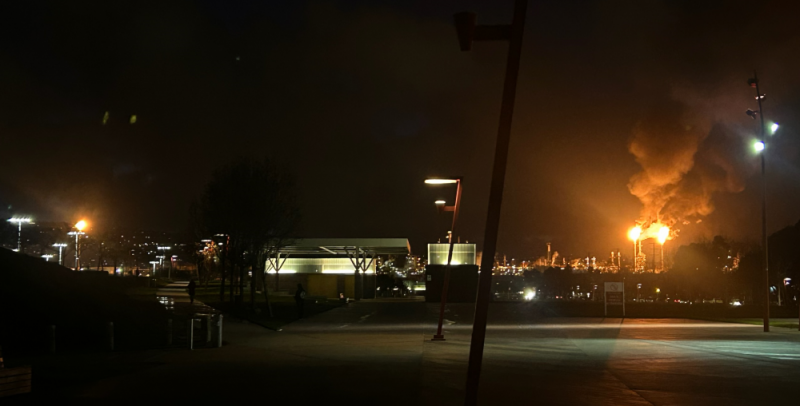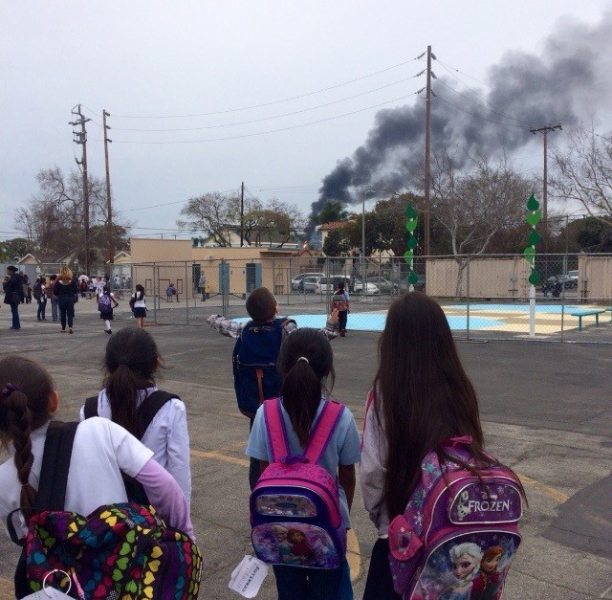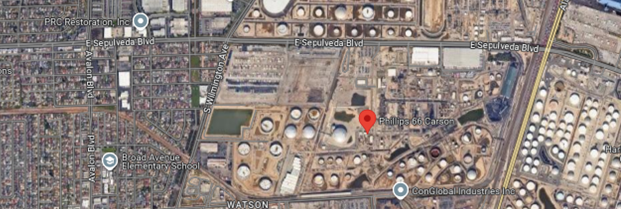The Phillips 66 LA Refinery closure notice was a big surprise.
Is fossil fuel phaseout finally picking up speed?
November 2024 | Julia May, Senior Scientist, CBE

On October 16th, 2024, seemingly out of the blue, Phillips 66 announced that at the end of 2025 it will shutter its Los Angeles refinery complex in Wilmington and Carson (where separate partial refineries a few miles apart work together as one integrated facility). (LA Times)
For neighbors, many who live smack up against the refinery and are burdened by high levels of asthma and cancer, the closure is a welcome surprise, a relief from toxic air pollution, and a hope to stop impending climate catastrophe. The Wilmington, Carson, W. Long Beach area has the highest concentration of oil refineries on the West Coast, and among these, Phillips 66 LA has one of the worst emission records for certain pollutants (below).
But the closure left hundreds of workers in the lurch without warning, despite this industry’s record profits over the years.
A backdrop of refinery accidents and a slew of toxic emissions

Emissions of Volatile Organic Compounds including cancer-causing benzene, and fine particulate matter from the five refineries in Wilmington and Carson (two Phillips, two Marathon, and one Valero) are even larger than mobile source emissions. Refinery Nitrogen Oxides, Sulfur Oxides, and a slew of toxic chemicals, add to the mix. (AQMD AB617 plan, p. 3b-6) These increase risks of asthma, cardiovascular disease, cancer and more in this community.
The California’s Office of Environmental Health Hazard Assessment 2019 statewide refinery report found: “. . . sulfur dioxide, hydrogen sulfide, and hydrocarbons were the most commonly reported chemicals emitted during refinery incidents. In many instances, adverse health effects were reported following the release of sulfur compounds. Symptoms were consistent with those associated with acute sulfur dioxide and/or hydrogen sulfide exposure: nausea; dizziness; irritation of the eyes, nose, throat, and skin; and unconsciousness.” p. 28
Among the Los Angeles refineries, Phillips 66 had the highest rate of Sulfur Oxide emissions from flaring (per barrel of crude oil processed). (SCAQMD, Table 3-3) And in 2020, the Phillips 66 Wilmington refinery was found under the AB2588 Air Toxics Hotspots Act to cause a significant cancer risk to thousands of neighbors, requiring warnings and a triggering a mandate to reduce the risk.

The neighborhood census blocks in Wilmington, Carson and West Long Beach between and around the refineries include some of the highest percentiles in the state for toxic air releases. As usual, Latine/x, Black, Asian, and other communities of color and low-income communities are by far the worst impacted.
That oil refineries are a dirty source of energy shouldn’t be a surprise. That the oil industry might be beginning to relinquish political and economic hold on California, however is a surprise.
Pro-fossil fuel parties painted the closure as a major problem, and tried to blame the Governor and recent legislation. Even Phillips debunked this.
Assembly Republican Leader James Gallagher, Yuba City and other industry cheerleaders blamed closure on Newsom and anti-gasoline price gouging legislation ABX2-1 (“Great work, Gavin”) (LA Times, 10/17/24) But Phillips stated the closure plans are a business decision, long in the works, and unrelated to legislation. (Phillips 66’s Los Angeles-area refinery closure not due to new California regulations: company, S&P Global, Oct 17, 2024)
An energy expert also reported: “You don’t shut down a refinery based on two or three weeks of planning. This has been in the works for at least a year.” (Dr. Borenstein, Energy Institute, U.C. Berkley’s Haas School of Business, in Gas prices unlikely to be affected by closure of Phillips 66 refinery …Expert, ABC7, 10/18/2024)
In reality, the new legislation is designed to ensure adequate supplies and enable billions of dollars in public savings.
People have good reason to fear gas prices, but the state found the closure should not cause price spikes or supply constraints — demand is going down fast and legislation provides new protections.
The California Energy Commission (CEC) indicated that gasoline demand will continue to significantly decline in 2025, 2026, and beyond. The CEC expects sufficient supplies even after the closure, due mainly to electric vehicle sales (now almost two million in California), based on data developed through the IEPR (Independent Energy Policy Report) process. Increased gasoline vehicle efficiency has also reduced demand. Furthermore, Phillips has stated it still intends to supply gasoline through its terminals.
Demand forecasts and planning don’t focus much on another source that could bolster California supplies – California exports. Refineries here regularly export substantial gasoline out of the country and to neighboring states. This portion could be upgraded to meet California demand.
Meantime, the Energy Commission achieved what no other agency has – cracking the code on the cause of gasoline price spikes hidden in refinery data
Using SBX1-2 (the 2023 Anti-Price Gouging bill), the Commission found one simple cause and solution to prevent occasional supply constraints when refineries shut down for maintenance. When reserves went below a 15-day supply, prices spiked. (See CEC and Gov. Newsom) New legislation was passed (ABX2-1), allowing requirements for refineries to keep this minimum on hand, thwarting spikes like those of the last two years.
Oil industry price gouging has been investigated in California and across the nation for decades. Everybody believes it happens, but it’s hard to prove. The CEC went straight to a new tool to avoid spikes, without having to prove manipulation. This doesn’t change the high baseline price or address the “Mystery Surcharge” on gasoline (unrelated to refinery costs or environmental regulation), but it can eliminate the overwhelming spikes. Continued Energy Commission work will be needed to uproot oil industry price manipulation.
But the real escape from gasoline price-gouging is to escape the use of gasoline. Long-term, electrification of transportation is cheaper than gasoline and other fossil fuel use, even without considering the overwhelming costs of health impacts and climate change. (See KochvsClean) Upfront costs are still prohibitive for low-income people, and more economic support for transportation electrification is necessary to allow us to be freed from an inherently expensive and toxic energy system.
What we should fear more than gas prices is accelerating climate change, predicted temperatures over 125°F, wildfires, hurricanes, and sea level rise.

Fortune Summary, and Original Technical Study
While gasoline prices are no joke – burdening low-income communities to the breaking point – the real solution is to escape all the cost of gasoline and other fossil fuels in a gradual and managed phase-out of their use. Incidentally, this will finally clean up deadly smog sixty years after adoption of the Clean Air Act, and save the planet.
It’s been three years since the U.N. IPCC found: “Climate change is widespread, rapid, and intensifying“. IPCC 2021 Since then, more climate disasters have occurred around the world. This will only get worse.
The sensible course: be glad toxic gasoline demand is declining, and plan a gradual and Just Transition to support communities and workers before refineries close, while phasing-in clean energy.
California already has demand-side regulations mandating gradually increasing transportation electrification, leading to no new gasoline vehicle sales by 2035 (though old vehicles can still operate post-2035.) (Advanced Clean Cars 2022). We still need to beef up programs subsidizing Electric Vehicles (EVs) for low-income people and expand public transit.
But supply-side fossil fuel phaseout requirements like the transportation transition are non-existent for refineries – regulators instead want to wait to see what the oil industry decides, as in the Phillips closure. For refineries, state emissions goals are implemented through mitigation measures and pay-to-pollute trading programs.
During Energy Commission proceedings, we proposed analysis of a Partial Refinery Shutdown Pathway, to avoid sudden, disruptive, whole-refinery closures until fewer refineries, through a combination of measures. Refinery production could be lowered to minimum allowable rates (since big distillation, cracking, and other units can’t operate below about 65-70% of capacity). This can be paired with gradually closing duplicate units in big refineries (in addition to other methods), while fuel demand declines over the next two decades. (See CEC docket: 4/25/24 CBE Julia May, 5/17/25 and 2/8/24 CBE/APEN comments). But so far, the state has not stepped in to coordinate an approach to thread this needle.
Gradual refinery phaseout planning and worker and community transition support needs development, but models and options are emerging.
A few examples of existing models to replace oil industry tax revenues for community support, and to move oil workers to green jobs include these (and others are in the works):
- The Richmond (California) Refining Business License Tax Act proposed in June 2024 called for reserves for future economic disturbances, to seed new industries and to address refinery impacts (detailed here). The city accepted it to be placed on the November ballot, which apparently scared Chevron enough to settle with the city, agreeing to forego this proposal, but to provide $550 million in payments over 10 years.
- The Diablo Canyon nuclear power plant closure worker Just Transition plan provided retirement for older workers and training for younger ones (more details here).
- Training for jobs that pay well: Electrician training for EV charging stations – which will be in high demand; Constructing new infrastructure especially needed in rural areas (for hospitals, schools, etc.), highlighted by Central Valley Environmental Justice leaders as one way to develop new jobs outside the oil industry; Nursing Training can provide entry to a high-demand field.
Some steelworkers (who operate oil refineries) have stated that unions have good re-training programs, but in the end, we have to make sure the jobs are there after the training. The expertise of refinery workers must also be recognized outside the industry, allowing lateral moves for workers too old to start again but too young to retire. Refinery operators are highly skilled at trouble-shooting dangerous, high-temperature, high-pressure, high volume, explosive and toxic operations, but other industries don’t always understand how these skills translate. (Refinery maintenance worker expertise tends to be more readily recognized by other industries.) Livelihoods and families need to be protected through the sweeping economic and energy changes already underway.
It’s irrational to think that we have no choice but to keep the costly and deadly oil industry going. This is a failure of imagination in the face of Big Oil’s political power, but the truth is – we don’t even need technological breakthroughs. It’s a matter of rolling up our sleeves, and doing the technical, economic, and practical planning, centering equity along the way. Let’s get going.
What will happen to the hundreds of acres of the Phillips LA property?

We’re not sure, and this bears watching.
- Phillips stated it will keep its fuel terminals and distribution to supply gasoline to California. This would continue air pollution from tanks, piping, and ships, but is less polluting than a whole operating refinery. (Phillips: “We are also not exiting California.”)
- Warehouses may be built. These are indirect pollution sources because they draw large numbers of diesel trucks, which will need to be evaluated to prevent neighborhood impacts. (Phillips 66 closure of South Bay refineries opens 650 acres for development)
- A biofuel refinery seems unlikely – the market is saturated, and Phillips would likely have announced at the same time as closure. Biofuel refineries are still major polluters.
- Will housing be built? Will the site be sufficiently cleaned up? We don’t know. Refinery sites are likely to be highly contaminated. This one operated for over 100 years. Phillips must be accountable for cleanup.
- There are many development possibilities.

